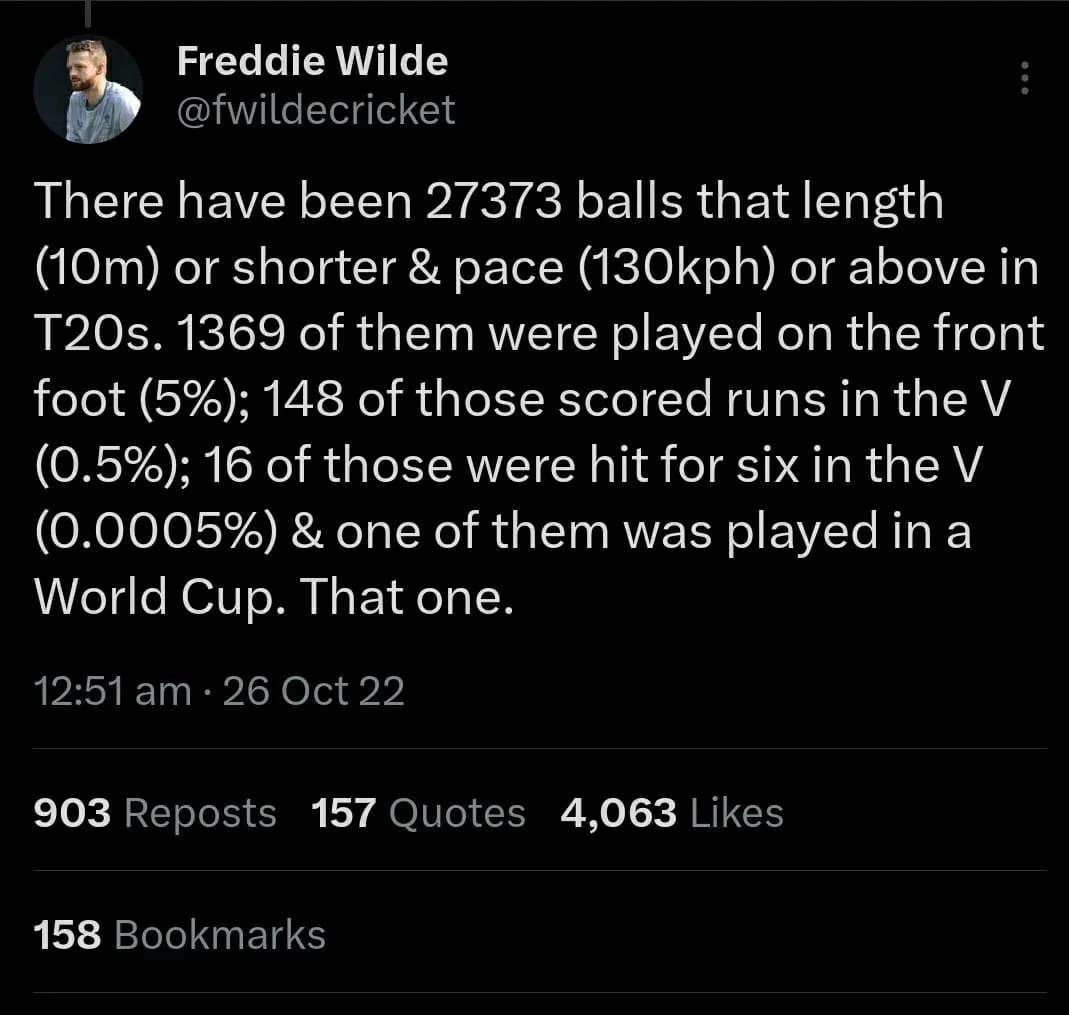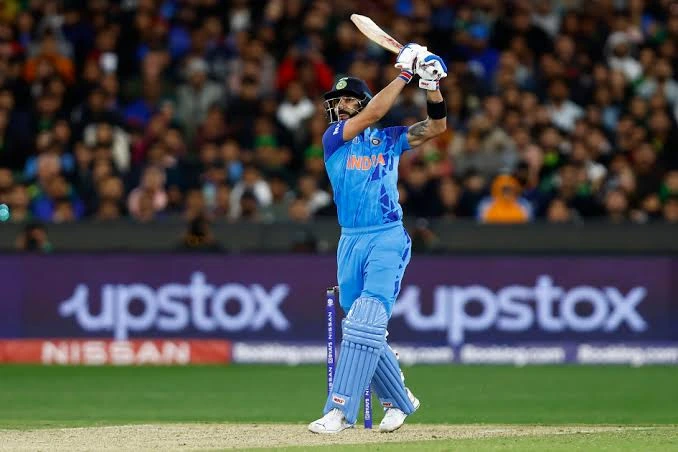“They cannot lose; he must not lose.” Peter Drury’s proclamation as Messi charged Argentina in a must-win game against Mexico in Qatar last year still induces goosebumps. Because a loss for Argentina would send them and Messi, in his last World Cup, back home before the knockouts. The next thing we know, Messi unfurled his magic, and the rest is history.
Similar sentiments were echoed, thought, and prayed for when Haris Rauf ran in to bowl to Virat Kohli the ball that is now famously, and joyfully, remembered, etched in stone, as the 18.5 delivery. We all know what happened. But are we really able to comprehend yet how unique that shot was?
People remember Sachin Tendulkar’s iconic cut shot six to Shoaib Akhtar in the 2003 World Cup game in Centurion as the icing on the cake as the Master led India to win. Or Ben Stokes’ audacity-defying reverse sweep on the Western Terrace to Nathan Lyon in that Headingley knock in 2019. But here, on this shot, for perhaps the only time in history, it is the match and the win that aren’t as much talked about as that shot from Kohli is.
How unique was that six from Virat Kohli?
“There have been 27373 balls that length (10m) or shorter & pace (130kph) or above in T20s. 1369 of them were played on the front foot (5%); 148 of those scored runs in the V (0.5%); 16 of those were hit for six in the V (0.0005%) & one of them was played in a World Cup. That one,” CricViz’s Freddie Wilde tweeted.
The one. That ONE.

For the unversed, fans hail Haris Rauf as the King of the MCG. I may not have the exact data at the moment, but on memory, I can strongly assert that no non-Australian bowler in the T20 World Cup last year had bowled as many balls at the MCG as Haris Rauf had done in his career in the Big Bash League, where he plays for the Melbourne Stars. He knows the pitch and ground better than most.
Rauf is a white-ball specialist pacer whose only aim in life seems to blast the lights out of the opposing batters with high pace. Couple his pace, his experience, and the bounce he gets from his height, along with the spiciness and sponginess of the MCG pitch that was served up in last year’s event, it all makes Rauf almost impossible to hit even across the line, let alone hit him down the ground as Kohli did.
It was with those traits that Rauf was seemingly taking Pakistan to a victory (which would have made two in two years for Pakistan over India in T20 World Cups) having dismissed India skipper Rohit Sharma and Suryakumar Yadav, the best T20 batsman in the world.
***
Virat Kohli had had the worst of luck from 2020 to mid-2022. Everyone who had a tongue and had seen even one dismissal of him in that period demanded his axing from the T20 side. “Not up to the modern T20 standards,” they’d say. A century against Afghanistan in the Asia Cup was belittled and even disregarded by few.
But India backed him. The tournament was in Australia; nobody in that side had had as much success and experience in Australian conditions as Virat Kohli did. And of course, he was not going to be dropped based on recommendations from ex-cricketers who had little idea about the modern T20 game or from Twitter trolls who’d pounce on anyone for traction.
So there he was then. India required 28 off 8. The same voice ran through everyone’s head: “Kohli must hit a boundary here.” India can’t drag the game to the last over with 25 needed. Rauf was looking unhittable. He had conceded only 24 runs in his first 22 balls. Until. The Shot Of The Century.
Whatever had to go right and needed to go right, did go right in favor of Kohli. Rauf, who could easily touch over 140 KPH, dropped his speed: maybe he wanted to surprise Kohli with a slight change of pace.
It is known that MCG’s straight boundaries are much shorter compared to its square boundaries. But what should also be noted is that even then, those straight boundaries look bigger compared to most of the other grounds.
Kohli backed himself, as he’d done throughout his rough patch, to clear the straight boundary. This is percentage cricket. You hope for some luck to go your way while looking to do the best you can in that situation. Control what you can control, do it right, and wish for some fortune. For all the luck that had deserted Kohli for two years, it was time that was being made up for.
A back-of-length delivery was almost predictable. What wasn’t predictable was how and where Kohli was going to take Rauf on.
Virat Kohli moved on the legside. Eyes widened. He loads his bat, and the backlift comes down as smoothly as ever. And Crack. 90,000 fans at the MCG and billions across the world waited in anticipation to see if the ball landed inside the field, in the hands of a fielder, or over the ropes. Well, it was well into the stands. Six. The feeling was visceral.
“Kohli has got to find a boundary against Rauf,” SEN Cricket commentator Gerard Whateley had said as Rauf ran in to bowl. A couple of seconds later he went wild: “That is a shot of an Emperor” Whateley evoking his inner Peter Drury.
Whatever the word pandemonium means, it was what it was at the MCG. Tunes of ‘Dil Dil Pakistan’ in bars and cafes turned into ‘Chak de India’. Mind you, the match hasn’t even been won yet. But it felt won there and then.
***
Doing it to Haris freakin Rauf, the MCG boy. The pressure of a World Cup India-Pakistan game. 90,000 in attendance, billions on their televisions and mobile screens. The most unique shot played in a T20 World Cup game. For the first time, the result took a backseat as Virat Kohli hit the Shot Of The Century.
Just as Shane Warne’s Ball of the Century to Mike Gatting in the 1993 Ashes is immortalized, Kohli’s shot to Rauf is too.

